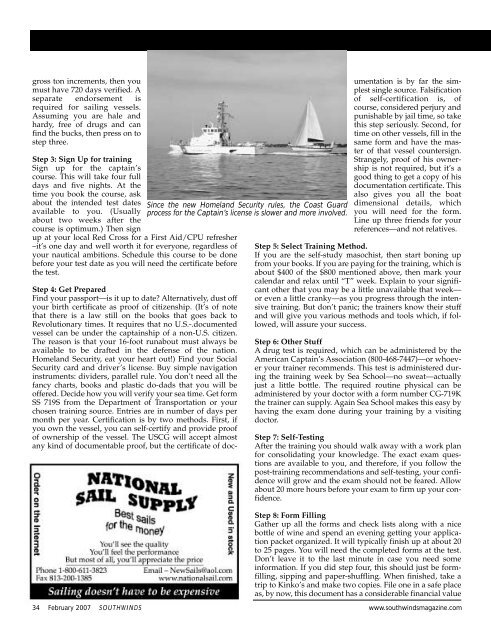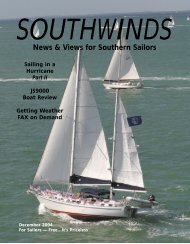Read PDF - Southwinds Magazine
Read PDF - Southwinds Magazine
Read PDF - Southwinds Magazine
Create successful ePaper yourself
Turn your PDF publications into a flip-book with our unique Google optimized e-Paper software.
gross ton increments, then you<br />
must have 720 days verified. A<br />
separate endorsement is<br />
required for sailing vessels.<br />
Assuming you are hale and<br />
hardy, free of drugs and can<br />
find the bucks, then press on to<br />
step three.<br />
Step 3: Sign Up for training<br />
Sign up for the captain’s<br />
course. This will take four full<br />
days and five nights. At the<br />
time you book the course, ask<br />
about the intended test dates<br />
available to you. (Usually<br />
about two weeks after the<br />
course is optimum.) Then sign<br />
up at your local Red Cross for a First Aid/CPU refresher<br />
–it’s one day and well worth it for everyone, regardless of<br />
your nautical ambitions. Schedule this course to be done<br />
before your test date as you will need the certificate before<br />
the test.<br />
Since the new Homeland Security rules, the Coast Guard<br />
process for the Captain’s license is slower and more involved.<br />
Step 4: Get Prepared<br />
Find your passport—is it up to date Alternatively, dust off<br />
your birth certificate as proof of citizenship. (It’s of note<br />
that there is a law still on the books that goes back to<br />
Revolutionary times. It requires that no U.S.-.documented<br />
vessel can be under the captainship of a non-U.S. citizen.<br />
The reason is that your 16-foot runabout must always be<br />
available to be drafted in the defense of the nation.<br />
Homeland Security, eat your heart out!) Find your Social<br />
Security card and driver’s license. Buy simple navigation<br />
instruments: dividers, parallel rule. You don’t need all the<br />
fancy charts, books and plastic do-dads that you will be<br />
offered. Decide how you will verify your sea time. Get form<br />
SS 719S from the Department of Transportation or your<br />
chosen training source. Entries are in number of days per<br />
month per year. Certification is by two methods. First, if<br />
you own the vessel, you can self-certify and provide proof<br />
of ownership of the vessel. The USCG will accept almost<br />
any kind of documentable proof, but the certificate of documentation<br />
is by far the simplest<br />
single source. Falsification<br />
of self-certification is, of<br />
course, considered perjury and<br />
punishable by jail time, so take<br />
this step seriously. Second, for<br />
time on other vessels, fill in the<br />
same form and have the master<br />
of that vessel countersign.<br />
Strangely, proof of his ownership<br />
is not required, but it’s a<br />
good thing to get a copy of his<br />
documentation certificate. This<br />
also gives you all the boat<br />
dimensional details, which<br />
you will need for the form.<br />
Line up three friends for your<br />
references—and not relatives.<br />
Step 5: Select Training Method.<br />
If you are the self-study masochist, then start boning up<br />
from your books. If you are paying for the training, which is<br />
about $400 of the $800 mentioned above, then mark your<br />
calendar and relax until “T” week. Explain to your significant<br />
other that you may be a little unavailable that week—<br />
or even a little cranky—as you progress through the intensive<br />
training. But don’t panic; the trainers know their stuff<br />
and will give you various methods and tools which, if followed,<br />
will assure your success.<br />
Step 6: Other Stuff<br />
A drug test is required, which can be administered by the<br />
American Captain’s Association (800-468-7447)—or whoever<br />
your trainer recommends. This test is administered during<br />
the training week by Sea School—no sweat—actually<br />
just a little bottle. The required routine physical can be<br />
administered by your doctor with a form number CG-719K<br />
the trainer can supply. Again Sea School makes this easy by<br />
having the exam done during your training by a visiting<br />
doctor.<br />
Step 7: Self-Testing<br />
After the training you should walk away with a work plan<br />
for consolidating your knowledge. The exact exam questions<br />
are available to you, and therefore, if you follow the<br />
post-training recommendations and self-testing, your confidence<br />
will grow and the exam should not be feared. Allow<br />
about 20 more hours before your exam to firm up your confidence.<br />
Step 8: Form Filling<br />
Gather up all the forms and check lists along with a nice<br />
bottle of wine and spend an evening getting your application<br />
packet organized. It will typically finish up at about 20<br />
to 25 pages. You will need the completed forms at the test.<br />
Don’t leave it to the last minute in case you need some<br />
information. If you did step four, this should just be formfilling,<br />
sipping and paper-shuffling. When finished, take a<br />
trip to Kinko’s and make two copies. File one in a safe place<br />
as, by now, this document has a considerable financial value<br />
34 February 2007 SOUTHWINDS www.southwindsmagazine.com

















